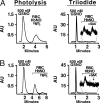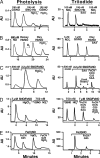Assessment of nitric oxide signals by triiodide chemiluminescence
- PMID: 17287342
- PMCID: PMC1892991
- DOI: 10.1073/pnas.0611191104
Assessment of nitric oxide signals by triiodide chemiluminescence
Abstract
Nitric oxide (NO) bioactivity is mainly conveyed through reactions with iron and thiols, furnishing iron nitrosyls and S-nitrosothiols with wide-ranging stabilities and reactivities. Triiodide chemiluminescence methodology has been popularized as uniquely capable of quantifying these species together with NO byproducts, such as nitrite and nitrosamines. Studies with triiodide, however, have challenged basic ideas of NO biochemistry. The assay, which involves addition of multiple reagents whose chemistry is not fully understood, thus requires extensive validation: Few protein standards have in fact been characterized; NO mass balance in biological mixtures has not been verified; and recovery of species that span the range of NO-group reactivities has not been assessed. Here we report on the performance of the triiodide assay vs. photolysis chemiluminescence in side-by-side assays of multiple nitrosylated standards of varied reactivities and in assays of endogenous Fe- and S-nitrosylated hemoglobin. Although the photolysis method consistently gives quantitative recoveries, the yields by triiodide are variable and generally low (approaching zero with some standards and endogenous samples). Moreover, in triiodide, added chemical reagents, changes in sample pH, and altered ionic composition result in decreased recoveries and misidentification of NO species. We further show that triiodide, rather than directly and exclusively producing NO, also produces the highly potent nitrosating agent, nitrosyliodide. Overall, we find that the triiodide assay is strongly influenced by sample composition and reactivity and does not reliably identify, quantify, or differentiate NO species in complex biological mixtures.
Conflict of interest statement
The authors declare no conflict of interest.
Figures





References
-
- Hess DT, Matsumoto A, Kim SO, Marshall HE, Stamler JS. Nat Rev Mol Cell Biol. 2005;6:150–166. - PubMed
-
- Stamler JS, Lamas S, Fang FC. Cell. 2001;106:675–683. - PubMed
-
- Foster MW, McMahon TJ, Stamler JS. Trends Mol Med. 2003;9:160–168. - PubMed
-
- Stamler JS. Circ Res. 2004;94:414–417. - PubMed
-
- Singel DJ, Stamler JS. Annu Rev Physiol. 2005;67:99–145. - PubMed
Publication types
MeSH terms
Substances
Grants and funding
LinkOut - more resources
Full Text Sources

